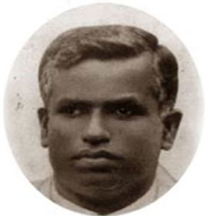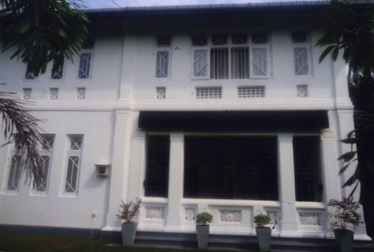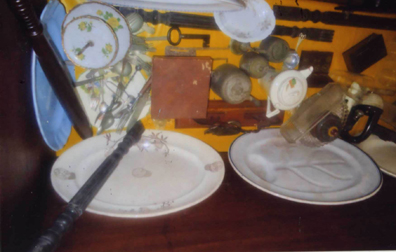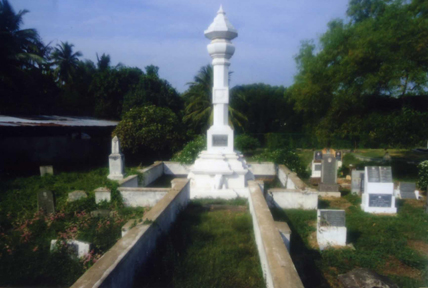|

Kumaratunga Munidasa |
Remembering Kumaratunga Munidasa:
The literary genius and defunct Foundation
Sinhala language lovers and the
Maha Sangha will commemorate the 72nd death anniversary of erudite
scholar, philosopher, linguist, grammarian, commentator, writer, poet,
and journalist, Pandit Kumaratunga Munidasa on March 2. Religious rites
will be held at 9 a.m. opposite the Kumaratunga Memorial at the Gorakana
Public Cemetery in Panadura. Pandit Munidasa died on March 2, 1944 at
his residence, 'Sevana' at Pallimulla, Panadura.
Pandit Kumaratunga Munidasa was a pioneer (Sinhala) linguist who
founded the 'Hela Havula 'movement which sought to remove Sanskrit
influences in the Sinhala language and promote its correct usage. One of
the most eminent scholars Sri Lanka has known for several centuries, he
is known best for his profound knowledge of the Sinhala language and
literary work. Yet, the foundation set to continue with his work has
become defunct, and construction work on a museum and a 'Dasunhala' in
his name has been abandoned halfway due to lack of funds.
Born on July 25, 1887, at Dickhena, Idigasaara, Dickwella, to Don
Abeya Kumaratunga, a physician practicing indigenous medicine who kept
invaluable Pali and Sanskrit manuscripts on Ayurveda, Astrology and
Buddhism, and Palavinnage Dona Gimara Muthukumarana, better known as Don
Nona Baba Muthukumarana, Munidasa received his preliminary education at
a Buddhist mixed-school at Dickwella and later, after his father's
death, joined St. Thomas', College, Matara, for further education.
Family's discontent
Later still he attended the Dickwella Watarukanna (Wewurukannala
Pirivena) Pirivena to learn Pali and Sanskrit, under the guidance of the
late Ven. Ananda NayakaThera. He intended becoming a Buddhist monk,
however, due to his family's discontent, he was compelled to give up the
idea and entered the Government Teachers' College in Colombo, after two
years of training, was he received his first appointment as a government
teacher at a Bilingual School of Bomiriya. Later he was promoted as
principal of the Kadugannawa Bilingual School.
|

Kumaratunga’s residence at Pallimulla, Panadura, where he
died on March 2, 1944. |
|

His plates and other items are kept in a pettagama
(traditional box). |
In 1917 he was appointed inspector of government schools, which post
he held for four years.
Kumaratunga Munidasa married Lilly Laviniya Peiris in Pallimulla,
Panadura in 1921. He had six children, four sons and two daughters.
In 1923 he was appointed principal of Nittambuwa Teachers' Training
College, during which time he wrote 'Kumarodaya'. However, his first
book was 'Nikaya Sangraha Vivaranaya', an analysis for scripture on
Buddhist monastic orders, written during his school days.
Munidasa wrote many books in many languages - in Sinhala, English,
Sanskrit, Pali, Tamil, Greek, Malayalam and Latin and was also
responsible to reviving 'Lakmini Pahana', one of the oldest Sinhala
newspapers. He is also credited with launching two magazines 'Subasa'
and 'Helio' to teach and promote the correct use of Sinhala. He also
wrote and published many literature books for schoolchildren to guide
them in the proper use of language.
Munidasa was a member of Sinhala Maha Sabha of the Swabhasha
movement, which started as a protest against the English educated elite.
He spoke of language, nation, and country as a triple gem, which was
the foundation for 'Hela Havula' movement, which comprised people who
shared his ideals. They often engaged in debates on literature and were
the starting point for many scholars and artists. The movement exists to
this very day.
In 1935, Munidasa published 'Piya Samara' and 'Sidath Sagarawa',
tomes on valuable literature and poetry, and in 1937, he published 'Kiyawana
Nuwana' for schoolchildren. Over the years he wrote dozens of books on
Sinhala literature with 'Kavisitu Mina' being one of the more popular
endeavours published in 1943.
Real traditions
Munidasa had unique and creative opinions and his concepts on Sri
Lankan history, language and literature have been controversial, though
his scholarly writings depicted the real traditions of the nation, with
regard to its philosophy and concept as well as the specific and precise
characteristics of the nation's linguistic usage.
He was of the conviction that the Sinhala Language was a full-fledged
language, during the history of the Polonnaruwa and Kotte periods. His
research was based on classical literary works that had been produced
during the golden era of Sinhala Literature, from the 12th to the 15th
century. He also argued that Vijaya was merely an invader and believed
in Ravana.
|

Kumaratunga Munidasa Memorial constructed at the Public
Cemetery at Gorakana, Panadura. |
He wrote many books to promote the standard of Sinhala Language and
Literature, and books for schoolchildren to mould their character. Most
of these books still remain popular, among them 'Heensaraya', 'Hath Pana'
and 'Magulkema'
All his endeavours in the sphere of literature were aimed at
revealing the Sinhala Language in its true form.
However, the Munidasa Kumaratunga Foundation at Pallimulla, Panadura
initiated by the government of the late Sirimavo Bandaranaike by an Act
of Parliament, has now become defunct. All the directors of the
Foundation have passed away. The Foundation acquired approximately one
acre of land and put up a building in his memory and also established a
library in his name, which was opened by the then Prime Minister,
Bandaranaike.
A museum and a Dasunhala were also to be constructed in his name. The
foundation stones were laid, but construction came to a halt half way,
due to the lack of funds.
Valuable literature books written and published by the late Munidasa
Kumaratunga are now in the custody of his grandson.
Reported - Kapila Somaratne, Panadura Group cor.
|

